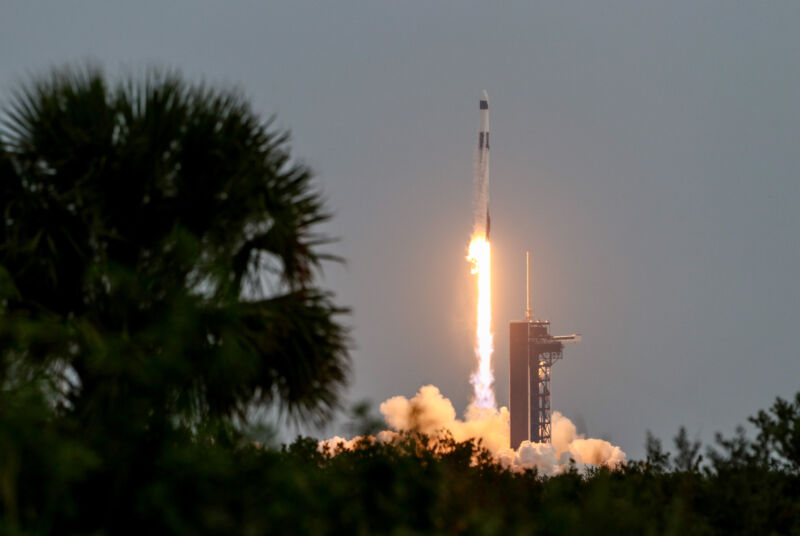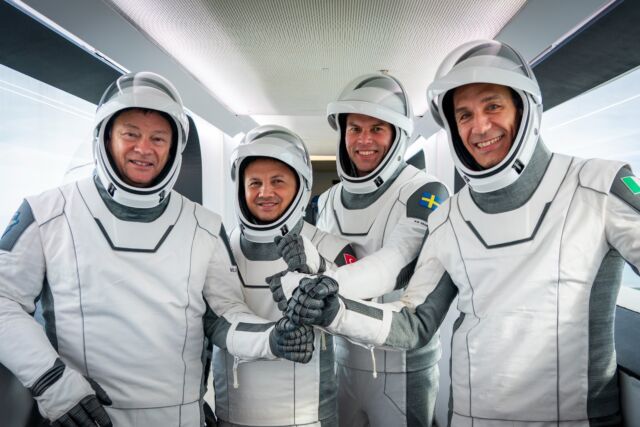Flying private —
A US-Spanish dual citizen commands a crew of Italian, Swedish, and Turkish astronauts.

Enlarge / A Falcon 9 rocket lifts off from NASA’s Kennedy Space Center to begin the Ax-3 commercial crew mission.
Stephen Clark/Ars Technica
For the third time, an all-private crew is heading for the International Space Station. The four-man team lifted off from NASA’s Kennedy Space Center in Florida aboard a SpaceX Falcon 9 rocket Thursday, kicking off a 36-hour pursuit of the orbiting research laboratory. Docking is scheduled for Saturday morning.
This two-week mission is managed by Houston-based Axiom Space, which is conducting private astronaut missions to the ISS as a stepping stone toward building a fully commercial space station in low-Earth orbit by the end of this decade.
Axiom’s third mission, called Ax-3, launched at 4: 49 pm EST (21: 49 UTC) Thursday. The four astronauts were strapped into their seats inside SpaceX’s Dragon Freedom spacecraft atop the Falcon 9 rocket. This is the 12th time SpaceX has launched a human spaceflight mission, and could be the first of five Dragon crew missions this year.
The Falcon 9 steered northeast from the Kennedy Space Center to line up with the flight track of the International Space Station. After darting through cloud cover, the rocket’s reusable first stage detached two-and-a-half minutes after liftoff to begin a descent back to Cape Canaveral for landing. The upper stage ignited a single engine to carry the Dragon capsule into orbit.
No retirement party
In remarks radioed to the ground soon after the launch, Ax-3 commander Michael López-Alegría describe the sensations of launch as “acceleration, a little bit of vibration, just a sense that you’re going fast. Wow, what a thrill!”
López-Alegría is a Spanish-born astronaut and US Navy veteran. He is one of the most experienced astronauts in history, and Ax-3 marks his sixth flight to space. López-Alegría, 65, retired from NASA in 2012 after four space shuttle missions. He worked as a consultant and commercial spaceflight advocate, then joined Axiom in 2017, and commanded the company’s first private astronaut flight in 2022.
So why keep up a grueling training schedule at an age when most commercial airline pilots face mandated retirement?
“It never gets old,” López-Alegría said in a prelaunch press conference. “I think I have more appreciation with every launch that approaches … The first time you go, you’re just hanging on for dear life and and enjoying the ride. But I think you appreciate each one a little bit more, especially when you realize just how rare and opportunity it is, so I’m happy to keep doing this.”
He is alternating commands of Axiom missions with Peggy Whitson, another retired NASA astronaut.
“Axiom would definitely like to continue doing private astronaut missions. We’ll probably have other commanders in the future, but as long as they ask me to fly, my hand will be raised,” López-Alegría said. He’s the first astronaut to fly on SpaceX’s Dragon spacecraft twice.
“I think you’re demonstrating the ultimate in reuse—a reused commander, a reused Dragon, and a reused Falcon, or maybe flight-experienced is a better word,” joked Bill Gerstenmaier, a SpaceX executive serving as chief engineer for Thursday’s launch.
Pilot Walter Villadei sat to López-Alegría’s right during the climb into orbit. He is a colonel in the Italian Air Force. Turkey’s first astronaut, Alper Gezeravcı, and Swedish test pilot pilot Marcus Wandt round out the Ax-3 crew. They will temporarily join the long-duration residents living on the space station, including four crew members who flew on a Dragon to the complex in August to begin a six-month stay.
Cornering the government market
Villadei, Gezeravcı, and Wandt are flying to the space station through contracts between their governments and Axiom. The astronauts, all military officers, will perform scientific experiments developed by their nation’s researchers, and participate in education and outreach events from orbit.
More than 30 research investigations are flying on Ax-3, ranging from biology physiology experiments looking at how microgravity affects the human body, to technology demonstrations and Earth science. For example, the Italian Air Force developed a software tool it will test on Ax-3 to provide space debris and space weather warnings to the space station. Turkey is sending up experiments in the fields of genetics and metallurgy. Sweden and the European Space Agency sponsor experiments in brain research, remote control and AI, and stem cells.

Enlarge / Michael López-Alegría, Alper Gezeravcı, Marcus Wandt, and Walter Villadei pose inside SpaceX’s crew access arm at Launch Complex 39A in Florida.
SpaceX
But there’s an unmistakable element of national pride intertwined with these scientific objectives.
Villadei is flying under the Italian flag through an agreement between the Italian government and Axiom, whereas most Italian astronauts have historically flown under the umbrella of the European Space Agency. He previously soared into space on a suborbital flight on Virgin Galactic’s spaceplane, logging a few minutes of microgravity. He was one of three Italian Air Force service members on the Virgin Galactic flight last June.
“This mission is very important for Italy,” Villadei said. “It’s a fundamental step in our national space strategy.”
Gezeravcı’s flight is historic in the sense that he is the first Turkish citizen to travel into space. “We have been long waiting for this mission to become real,” he said. “I’m really honored to take this role in this mission and to be able to make it real.”
Wandt’s mission was made possible through an agreement between ESA and the Swedish National Space Agency. ESA then finalized an agreement with Axiom to secure Wandt’s seat on Ax-3.
Wandt’s presence on the crew marks a first for ESA. It’s the first time the space agency has flown one of its astronauts to orbit with a commercial company, rather than an intergovernmental agreement with the United States or Russia. He was one of 17 astronauts ESA selected in 2022, but he joined ESA’s ranks as a reserve astronaut, meaning he would continue his career as a test pilot at Saab Aeronautics until his selection for a space mission.
He didn’t have to wait long. “This additional flight came up and Sweden was very decisive in this and came together quickly with industry, the armed forces, government, and together with ESA made this happen together with Axiom,” Wandt said.
ESA has six active astronauts who have flown in space, plus five new career astronauts and 12 reserves selected in 2022. Commercial flight opportunities like this one with Axiom enable more Europeans to access space. An ESA reserve astronaut from Poland could launch on an Axiom mission later this year.
“We have our astronaut corps, who represent the spine of our activities in human spaceflight,” said Daniel Neuenschwander, ESA’s director of human and robotic exploration, in an interview with Ars on Thursday. “But we selected also these reserves, which is a kind of pool of talent, where we seize the opportunities which come on top. It allows us to do more activities in human spaceflight.”
Axiom doesn’t publicize seat prices for its missions to the space station, but in the past, they have reportedly cost around $55 million. Swedish media last year reported Sweden expanded its investment in ESA by more than 400 million Swedish krona, or more than $38 million at current exchange rates, to enable Wandt’s spaceflight opportunity.
Axiom officials view flying government-backed astronauts as a lucrative market. It’s distinct from the conventional image of wealthy space tourists who pay their own way into orbit. There is, of course, an element of that in Axiom’s business, too. Axiom’s first mission in 2022 flew three self-paying private astronauts, and Ax-2 last year flew a mixed crew consisting of an Axiom commander, a US businessman, and two Saudi astronauts flying on a government-sponsored mission.
NASA is also supporting these private astronaut missions. The US space agency opened up the International Space Station to private visitors flying on all-commercial missions in 2019. It’s a cornerstone of NASA’s strategy to foster a commercial market for human spaceflight in low-Earth orbit, with an eye toward eventually building a business case for a privately-owned space station to replace the ISS after its planned retirement in 2030.